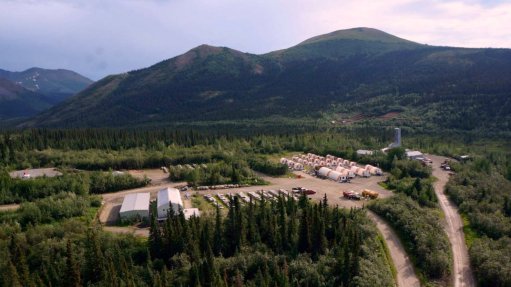
The camp at Bornite, Alaska.
Photo by: Trilogy Metals
Permitting for the 340 km road that will open up the prospective Ambler mining district, in Alaska, to resource development is in its final stages and a record of decision (RoD) is expected "imminently, possibly in the next month".
The Alaska Industrial Development and Export Authority is advancing the long-sought link to the Ambler district, which will cost $520-million.
A positive RoD will open the way for engineering and construction of the road, which is key to Vancouver-based Trilogy Metals and partner South32’s plans for the remote mining region.
The companies in January formed Ambler Metals, which is a 50:50 joint venture (JV) focusing on the polymetallic volcanogenic massive sulphide (VMS) style deposits of Ambler. South32 contributed $145-million to the JV and Trilogy all the assets, the two most advanced being the Arctic and Bornite projects.
“The road is extremely important not only for the development of the Arctic project, but also the development of the district as a whole, which is ultimately what our goal is,” Trilogy CEO Tony Giardini said in a webcast this week.
In a slide highlighting the district’s rich copper, zinc, lead, gold, silver and cobalt potential, the company notes that the prospects are like a “high-grade string of pearls”.
“We are talking about a VMS district that is no different to some of the prolific districts that have been discovered worldwide. Those districts have typically run for 75, 80 to 100 years. We see lots of opportunity to extend the mine life at Arctic and we see lots of opportunity for other developments in the area as a whole,” Giardini said, adding that the regional potential was really what drew South32 to the JV.
The $799.6-million Arctic project currently has a mine life of 12 years and will produce three high-quality concentrates: copper, zinc and precious metals. Its yearly average production will be 159-million pounds of copper, 199-million pounds of zinc, 33-million pounds of lead, 3.3-million ounces of silver and 30 600 oz of gold.
The 2018 prefeasibility study for the Arctic project describes the potential technical and economic viability of establishing a conventional openpit mine-and-mill complex for a 10 000 t/d operation. It calculated an aftertax net present value of $1.4-billion and an internal rate of return of 33%, with a two year payback period.
“Arctic has an exceptionally high copper-equivalent grade of 5%. It also has gold and silver credits. This is a quality deposit that has a very small footprint overall,” said Giardini.
The gold and silver credits could be used to provide capital to move the Arctic project forward and he noted that the asset was suitable to a royalty or streaming venture.
A new feasibility study is under way and should be completed in the “next month or so”.
Permitting for Arctic will also start in the second half of the year, with the US Army Corps of Engineers (USACE) expected to be the lead agency. Giardini does not expect any political roadblocks to the development of the project, noting that the USACE will be looking at its technical merits.
Meanwhile, the management of Ambler Metals should be appointed shortly. Giardini notes that Trilogy and South32 are busy staffing the JV, which will have an independent management team, comprising a president and CEO, COO and CFO on JV level.